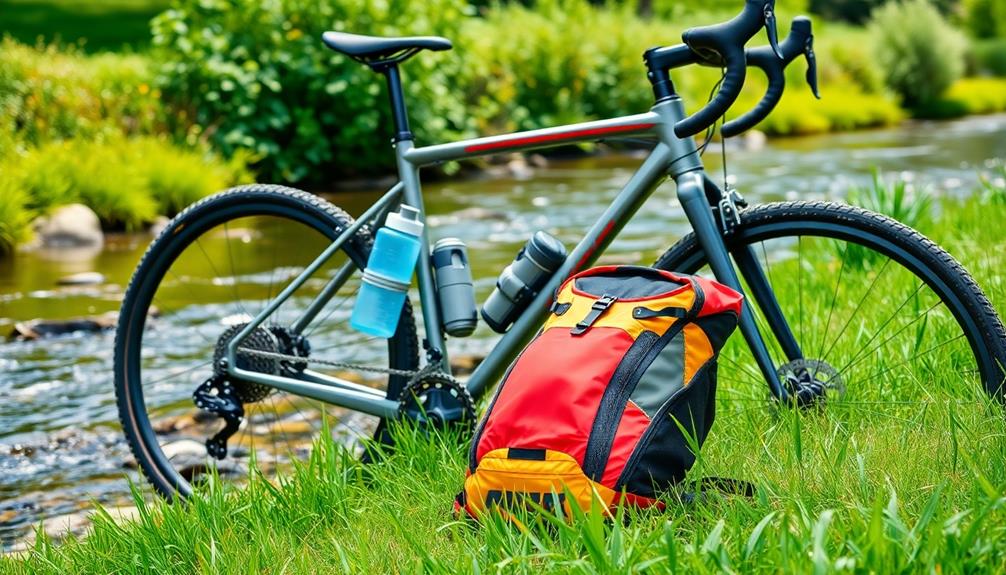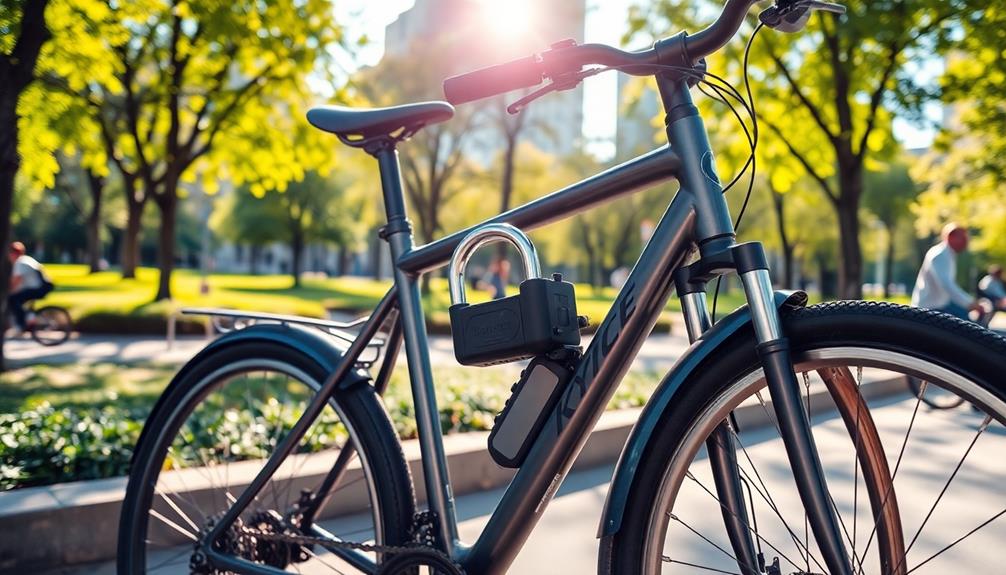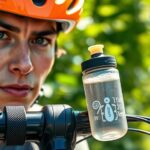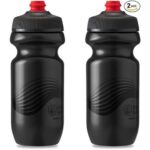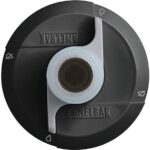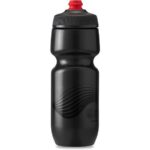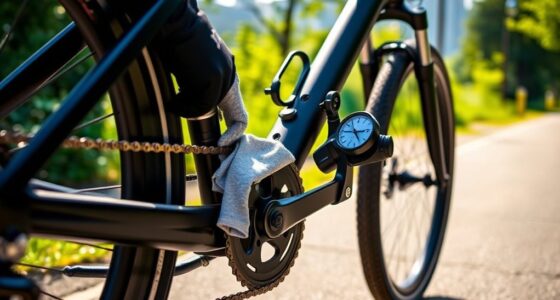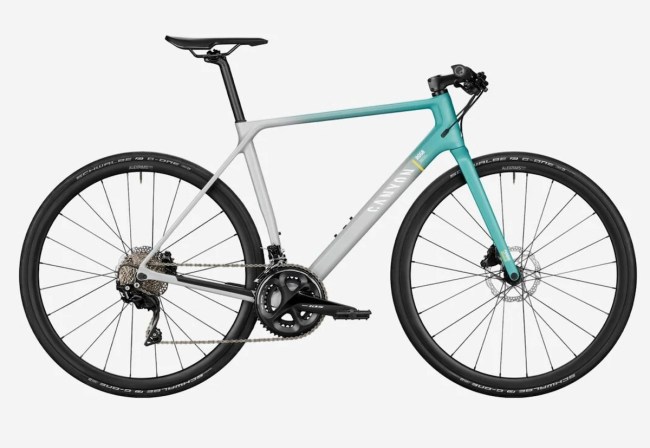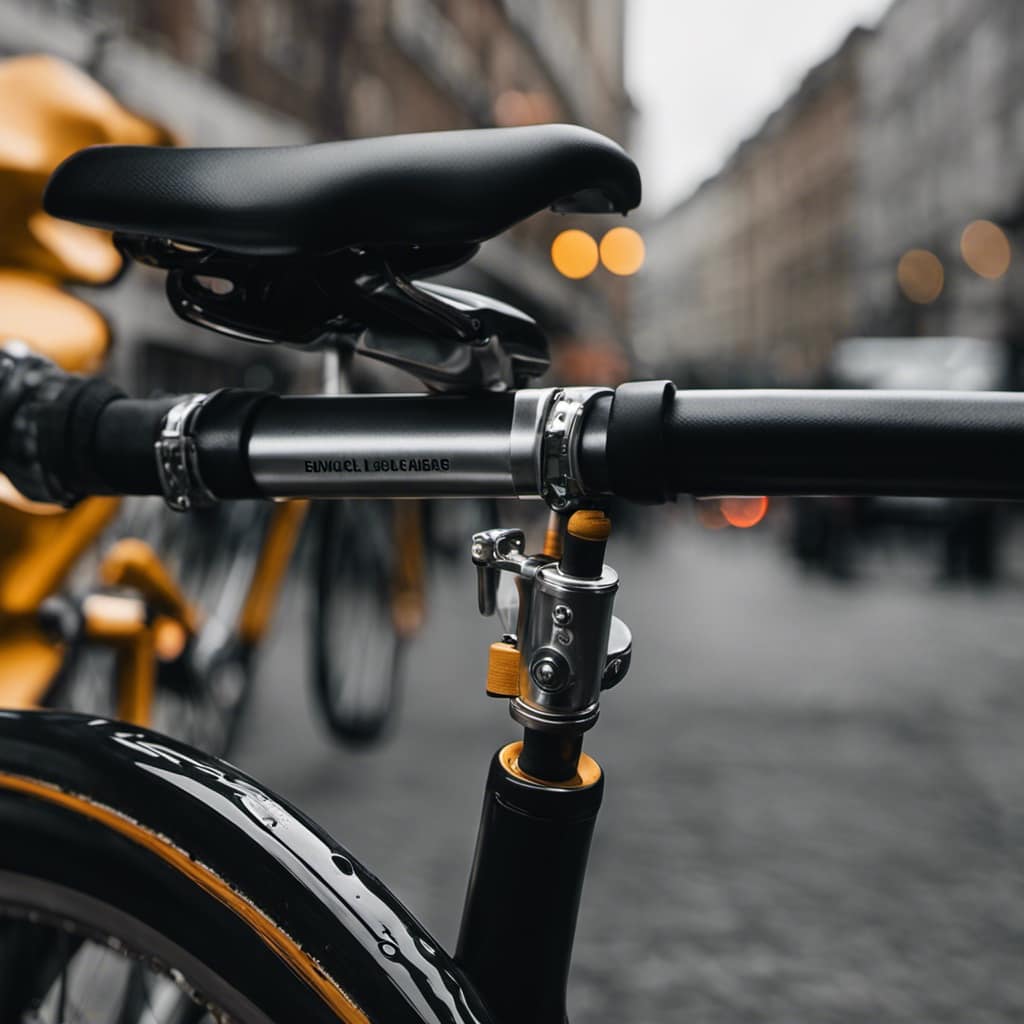When choosing a hydration system for your hybrid bike, consider your ride's duration and terrain. Water bottles, ranging from 500 mL to 1 L, work great for short trips, offering easy access and quick refills. For longer rides, hydration packs hold 1 to 3 L, allowing hands-free sipping while you pedal. While bottles can heat up in the sun, packs keep water cooler longer. Ultimately, balancing both systems lets you optimize hydration for various conditions. If you're curious about how each option impacts your ride, there's plenty more to explore.
Key Takeaways
- Hydration bottles are ideal for short rides (up to 2 hours) due to their easier access and quick refilling capabilities.
- Hydration packs offer hands-free drinking and are better suited for longer rides (over 2 hours) with larger water capacity.
- Proper hydration enhances performance, with cyclists needing 500-1000 mL of water per hour during rides.
- Bottles provide better ventilation and aerodynamics, while hydration packs can increase drag and limit airflow.
- Regular maintenance is crucial; bottles are easier to clean compared to hydration packs, which require more effort to prevent contamination.
Hydration Methods Overview
When it comes to staying hydrated on your hybrid bike, you'll find a couple of popular methods: hydration bottles and hydration packs. Hydration bottles typically hold between 500 milliliters to 1 liter of water, making them perfect for quick access during road cycling or shorter rides. They're easy to clean and refill, so you won't waste time fiddling with equipment when you're parched.
Additionally, staying hydrated can enhance your overall performance and emotional resilience, aiding in coping with the physical demands of cycling while allowing you to enjoy the ride more fully. This aligns with the importance of mental well-being in physical activities.
On the other hand, hydration packs can carry more water, usually between 1 to 3 liters. They're great for extended rides, offering hands-free drinking via a tube system, so you can sip without stopping. However, filling hydration bladders on the go can be cumbersome, and they require careful maintenance to keep them clean and prevent contamination.
Combining both methods allows you to optimize your water capacity and convenience. You can stick with bottles for shorter jaunts and use hydration packs for longer adventures.
Plus, the insulation in hydration packs helps keep your water cooler for longer, while bottles can heat up under the sun. Ultimately, choosing the right hydration method can notably impact your ride experience.
Comparing Capacity and Convenience

Choosing the right hydration method can greatly affect your ride, especially when it comes to capacity and convenience. Water bottles typically hold up to 2.5 liters, making them a solid choice for short to medium rides. On the other hand, hydration packs can accommodate between 1 to 3 liters, which is perfect for longer rides where you want to minimize stops for refills.
Additionally, just as selecting the right fuel for a wood stove can enhance efficiency and reduce emissions, choosing the appropriate hydration system can improve your overall riding experience by keeping you hydrated more effectively sustainable heating benefits.
When it comes to convenience, hydration packs shine. They allow for hands-free drinking through a drinking tube, letting you sip while you ride without having to stop or slow down. In contrast, accessing water bottles requires you to pause, which can disrupt your flow.
However, refilling water bottles is generally quicker and easier compared to filling hydration bladders, which can be cumbersome, especially on the go.
While water bottles are simpler to clean and maintain, hydration packs often keep your water cooler for extended periods due to superior insulation—ideal for hot days.
Ultimately, your choice should reflect your ride duration: opt for bottles on shorter trips and hydration packs for extended adventures where water sources might be scarce.
Comfort and Usability Factors
Comfort and usability are essential considerations in selecting a hydration system for your hybrid bike. If you prefer hands-free drinking to maintain your pedaling rhythm, hydration packs might be the way to go. They let you sip without stopping, which can enhance your ride.
However, some riders find hydration packs uncomfortable due to back sweat and weight distribution. In contrast, bottles keep the weight off your back, potentially increasing comfort. Additionally, staying hydrated is crucial for overall performance, much like using essential oils for toothache relief can enhance comfort during rides.
Accessibility is another factor. While bottles are often easy to reach, their mounting location on the bike can sometimes make it tricky to grab without stopping or adjusting your position. If you're an older rider or have flexibility issues, you might find bottles easier to access, adding to their usability.
On the other hand, hydration packs can limit airflow to your back during rides, increasing heat and discomfort. Bottles, meanwhile, provide a more ventilated experience.
Ultimately, your personal comfort with hydration methods will dictate your choice. Consider how each system aligns with your riding style and comfort needs to make the best decision for your hybrid bike adventures.
Impact on Performance
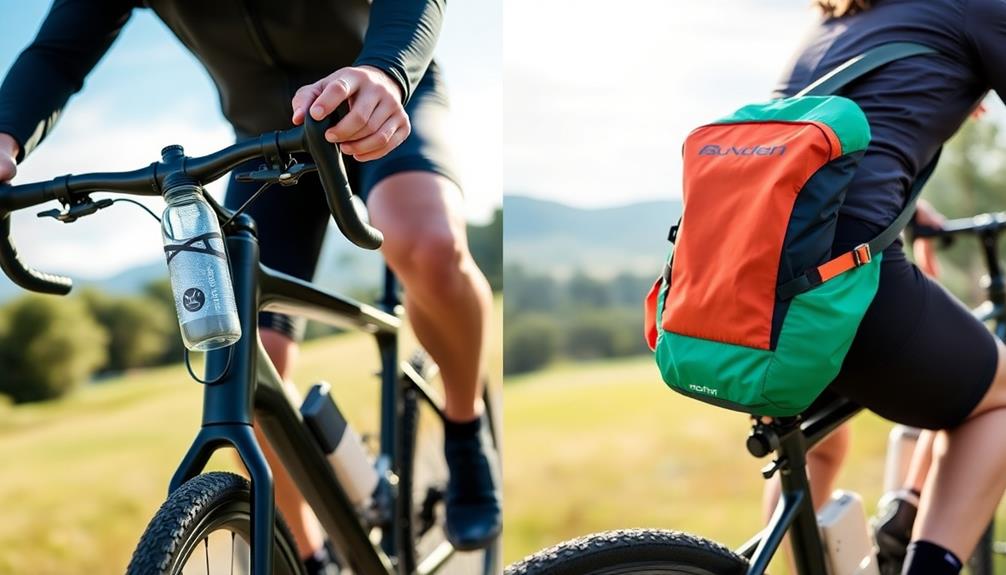
When you're cycling, staying hydrated frequently is essential for maintaining your performance.
Utilizing proper hydration techniques can enhance your endurance and keep you feeling energized throughout your ride.
The choice between hydration packs and bottles can impact your aerodynamics, affecting how efficiently you ride.
By understanding these factors, you can optimize your hydration strategy for better endurance and speed.
Additionally, experimenting with different hydration methods can yield insights similar to those found in aquatic exercise benefits.
Hydration Frequency Importance
Proper hydration frequency is essential for maintaining peak performance on your hybrid bike, as even slight dehydration can hinder your endurance and elevate your perceived effort during rides.
To sustain hydration levels, aim for approximately 500-1000 mL of water per hour, depending on the intensity of your ride and environmental conditions. Keeping your hydration equipment easily accessible, like using high refresh rates on gaming projectors, allows for a seamless experience while biking.
Using hydration bladders can greatly enhance your drinking frequency since they offer hands-free access, making it easier to sip while maneuvering challenging terrains. This is particularly beneficial during long rides when stopping to drink mightn't be practical.
However, hydration bottles also have their advantages. They allow you to monitor your water consumption more effectively, encouraging you to drink regularly and avoid the pitfalls of dehydration.
Aerodynamic Considerations
Hydration systems play a significant role in your cycling experience, not just for maintaining fluid levels but also for influencing your performance through aerodynamics. When you choose between hydration packs and water bottles, consider how each option affects your speed and efficiency on the bike.
Hybrid bikes, known for their versatility on various terrains, can benefit from an optimized hydration system to further enhance performance on commutes or recreational rides. Additionally, a well-fitted hydration system complements the bike's lightweight frame, allowing for quick shifts between riding styles, which is essential for urban environments versatility of hybrid bikes.
- Hydration packs are bulkier, increasing drag and reducing aerodynamic efficiency.
- Streamlined water bottles are designed to fit within bike frames, minimizing air resistance.
- Bottles mounted on the frame offer better aerodynamic positioning compared to packs worn on your back.
- Using water bottles allows for more efficient riding positions, as they're accessible without significant body movement.
Studies show that carrying hydration packs can raise your frontal area, leading to a notable drop in performance due to increased wind resistance. In contrast, water bottles enable you to maintain a lower profile, optimizing your aerodynamic shape.
Maintenance and Cleanliness

Maintaining cleanliness in your hydration system is vital for your health and performance. Regularly cleaning your hydration system can help you avoid issues similar to those faced when using cold medications that may have potential side effects from contamination.
You'll find that water bottles are much easier to clean compared to hydration packs, which require more attention to detail, especially with the tubing.
Regular cleaning helps prevent contamination from mold and bacteria, so don't overlook this important task.
Cleaning Frequency Comparison
When it comes to cleaning frequency, water bottles and hydration packs differ greatly in maintenance demands.
Water bottles are generally easier to clean, requiring less frequent upkeep due to their straightforward design. You can typically rinse them out and give them a quick scrub with soap and water. For those looking to enhance their hydration strategies, it's important to evaluate options that align with their dietary goals, such as low carb fast food options.
In contrast, hydration packs need regular cleaning to avoid mold and bacteria growth, often needing specialized cleaning tablets or kits.
Here's a quick comparison for you:
- Water Bottles: Rinse and clean quickly; can go longer without cleaning if filled with water only.
- Hydration Packs: Require dismantling for a thorough wash; clean after each use if containing anything other than water.
- Maintenance: Bottles demand less frequent maintenance compared to packs.
- Health Considerations: Neglecting cleaning, especially for hydration packs, can lead to health issues.
Keeping these points in mind will help you choose the right hydration system for your hybrid bike while ensuring you're maintaining proper hygiene practices.
Contamination Risks Explained
Proper maintenance is essential for avoiding contamination risks in hydration systems. Water bottles are generally easier to clean than hydration bladders, which can harbor bacteria if not regularly maintained. It's important to clean your bottles often, but keep in mind that hydration packs require more attention. You should consider cleaning your hydration bladder after every few uses to prevent mold and mildew buildup inside the reservoir and tubing.
Additionally, using safe hydration options can help reduce the risk of contamination, similar to how cilantro is safe in moderation for dogs when properly introduced. Hydration packs present higher contamination risks due to spittle accumulation in the drinking tube, so thorough cleaning after each use is critical.
For hydration bladders, you might need special cleaning tools, like cleaning tablets or brushes, to effectively tackle any stubborn buildup. When using bottles, always verify they're filled only with clean water or designated fluids. Using various liquids can complicate cleaning and raise hygiene concerns, making it important to stick to safe options.
Ultimately, staying proactive with your cleaning routine will help you enjoy safer hydration on your rides, whether you prefer bottles or hydration packs. Remember, a little effort goes a long way in maintaining the cleanliness of your hydration system.
Temperature Control and Insulation
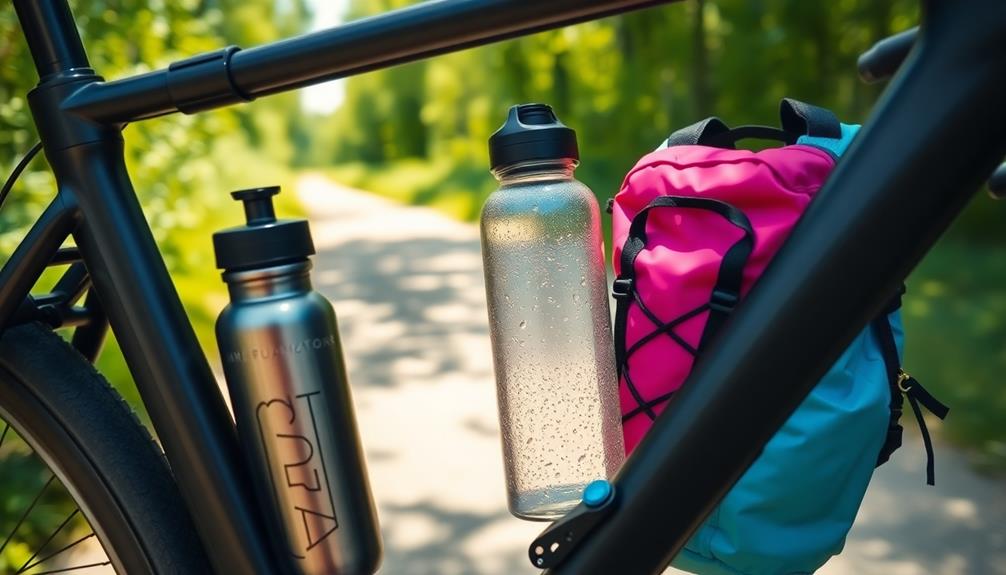
To keep your hydration experience as invigorating as possible, temperature control and insulation play an essential role in hydration systems for hybrid bikes.
When you're riding in the heat, staying cool and revitalized is vital. Hydration packs typically outperform standard water bottles in this regard, thanks to their built-in insulation features, similar to how Apple's commitment to user data protection enhances privacy in technology.
These packs help maintain cooler water temperatures for longer periods, while water bottles can quickly heat up under direct sunlight.
Consider these key points when choosing your hydration system:
- Insulated Hydration Packs: Designed to keep water cooler, even during long rides.
- Temperature Control: Helps maintain invigorating water temperatures throughout your journey.
- Insulated Water Bottles: A great alternative that can notably improve your hydration comfort.
- Direct Sunlight Exposure: Bottles tend to lose temperature retention faster than hydration bladders.
Terrain and Ride Duration
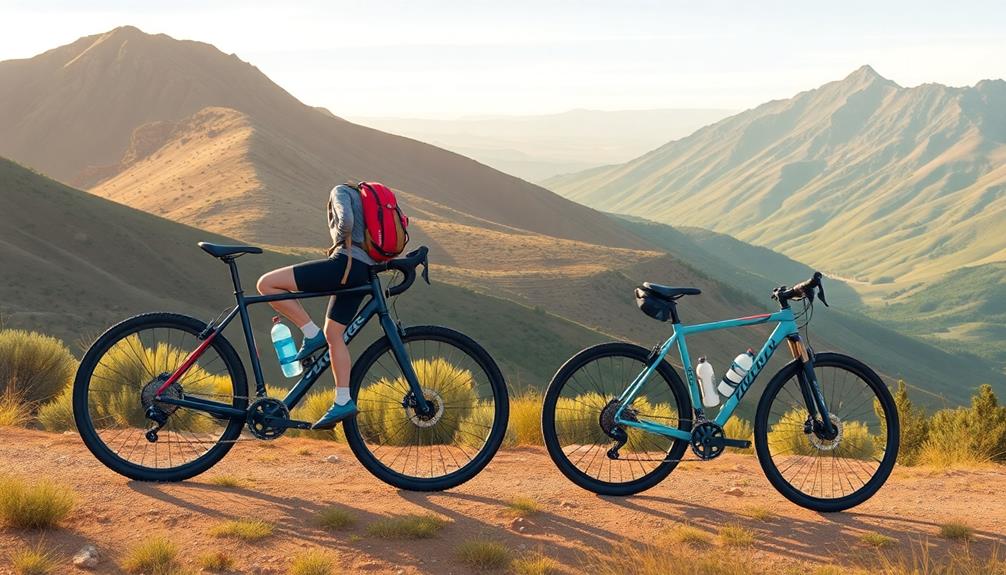
When you're planning a ride, the terrain and duration play a vital role in your hydration choice.
If you're tackling rough trails for more than two hours, a hydration pack might be your best bet for easy access and stability.
On smoother paths, a simple water bottle can keep you refreshed without the fuss.
Terrain Considerations for Hydration
Choosing the right hydration system for your hybrid bike ride often hinges on the terrain you'll encounter and how long you'll be out. For shorter rides up to 1.5 hours, water bottles are ideal. They're easy to refill and provide quick access to hydration.
However, for long rides exceeding 1.5 hours, especially on varied terrains, hydration packs with bladders become advantageous. They can hold 1 to 3 liters, allowing for hands-free drinking without stopping.
Consider these terrain factors when deciding:
- Off-road terrain: Hydration bladders offer stability and fit securely in various locations, minimizing the risk of losing bottles.
- Smooth roads: Water bottles shine here, as they're simple to clean and refill, enabling quick hydration breaks.
- Environmental conditions: Heat can increase your hydration needs, sometimes up to 3 liters for rides longer than 2 hours.
- Ride duration: The length of your ride directly influences your hydration method, with longer rides favoring packs for convenience.
Ride Duration Impact
Ride duration considerably impacts your hydration choices, especially as the length of your outing increases. For rides lasting up to 2 hours, water bottles are generally preferred. They're easy to use, allowing quick access and refills with their typical capacity of around 24 ounces.
However, as your ride extends beyond 1.5 hours, especially in hot conditions exceeding 85°F, hydration packs become more appealing. These packs can carry more water, often ranging from 1 to 3 liters, ensuring you stay hydrated during longer adventures.
If you're tackling off-road terrain, hydration bladders offer stability and hands-free drinking, allowing you to focus on maneuvering challenging paths. On smoother, paved roads, bottles are often favored for their simplicity and cleanliness.
It's crucial to recognize how temperature affects your hydration needs as well. In warmer weather, you might find yourself consuming up to 3 liters of water during summer rides.
Ultimately, your hydration system should align with both your ride duration and the terrain. Choosing between bottles and hydration packs will help keep you comfortable and hydrated throughout your cycling experience.
Environmental Factors Affecting Choices
The environment plays a significant role in how you choose to hydrate during your rides. Factors like terrain and ride duration can heavily influence your hydration choices.
For instance, if you're tackling technical trails, you might lean toward bottles since they're easier to manage and less likely to shift during aggressive maneuvers. On the other hand, if you're traversing off-road paths, hydration packs provide stability and allow for hands-free drinking, making them a popular choice.
Consider these points when deciding:
- Terrain Type: Technical vs. smooth surfaces can dictate your comfort with bottles or packs.
- Ride Duration: Short rides under two hours often call for bottles, while longer excursions benefit from the larger capacity of hydration packs.
- Environmental Conditions: Hot weather increases fluid needs, making packs that hold up to 3 liters more advantageous.
- Accessibility: Water bottles are easier to refill on short rides, while packs cater to remote areas with limited water sources.
Ultimately, understanding how environmental factors affect your hydration choices can enhance your riding experience.
Personal Preferences and Experiences
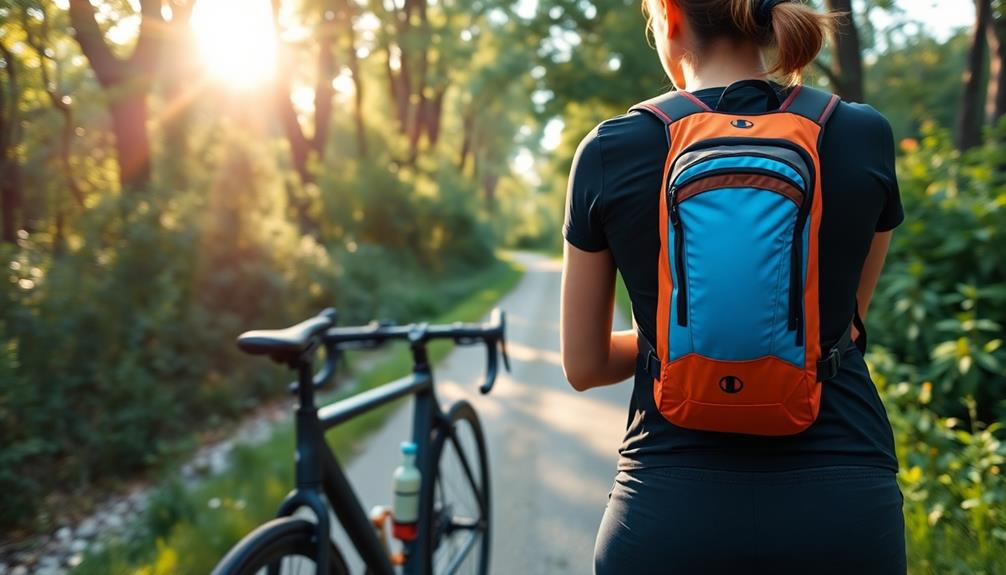
Many cyclists have distinct preferences when it comes to hydration systems, often influenced by the duration of their rides and personal comfort. For rides up to two hours, you might find that water bottles are your go-to choice. They're easy to access and refill, allowing you to stay hydrated without hassle.
However, if you're planning long rides, hydration packs may be more suitable for you. They offer hands-free drinking, which means fewer stops and a more uninterrupted ride.
Your comfort with either option can vary greatly based on factors like age and flexibility. You may appreciate the minimal gear of bottles, or you could enjoy the larger capacity that hydration packs provide.
Individual experiences tell a varied story; while hydration packs can feel liberating, some riders report discomfort due to back sweat and the added weight on their backs.
Ultimately, many cyclists prefer a combination of both bottles and hydration packs. This approach offers versatility, enabling you to optimize your hydration strategy according to the terrain and intensity of your ride.
Your personal preferences will guide you in finding the perfect balance that works for you.
Exploring Waist Packs and Hip Bags

For cyclists seeking a streamlined solution, waist packs and hip bags offer a minimalistic approach to hydration without the bulk of traditional backpacks.
These options enhance comfort and breathability during rides, making them ideal for those who want to avoid the discomfort of back sweat. While waist packs typically provide less water capacity than other hydration systems, they're perfect for shorter rides or when you don't need to carry much gear.
Well-designed hip packs fit snugly, preventing sagging and allowing freedom of movement. Plus, they often include extra storage for tools and snacks, striking a balance between hydration and gear accessibility on the go.
Consider these benefits:
- Lightweight design: Reduces the load on your back.
- Enhanced breathability: Keeps you cooler during rides.
- Snug fit: Prevents discomfort and distractions.
- Additional storage: Convenient space for essentials.
Choosing the Right System
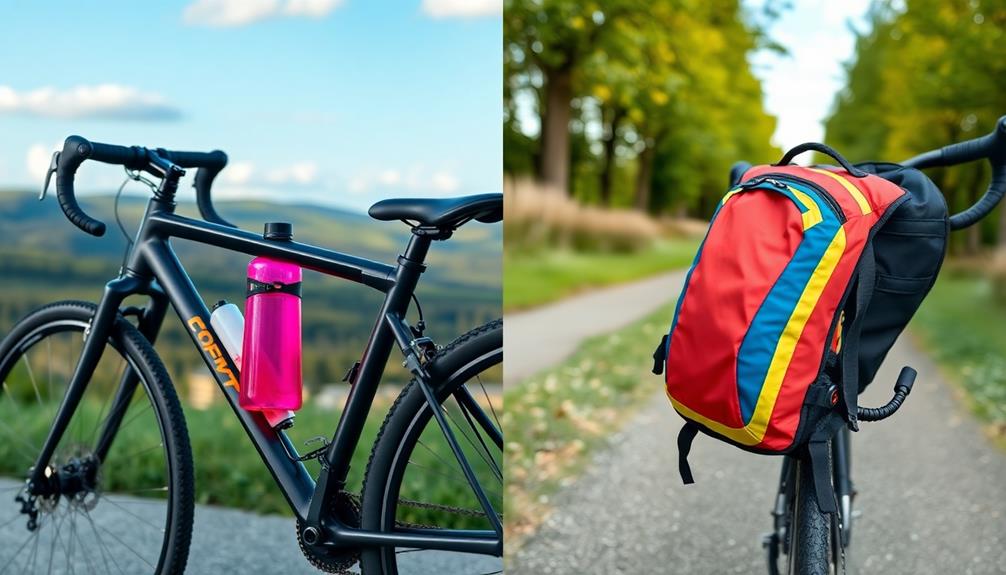
Choosing the right hydration system for hybrid biking involves evaluating your specific needs and riding habits. Both bottles and hydration packs have their advantages, so it's crucial to take into account factors like capacity, ease of cleaning, and convenience.
| Feature | Water Bottles | Hydration Packs |
|---|---|---|
| Capacity | 500ml – 1 liter | 1 – 3 liters |
| Cleaning Ease | Easy to clean | Requires careful cleaning |
| Hands-free Drinking | Requires stops | Hands-free convenience |
If you're planning shorter rides, water bottles are lightweight and easy to clean. They're perfect for quick hydration but may require frequent stops. On the other hand, hydration packs are ideal for longer journeys, allowing you to carry extra water without stopping. They offer hands-free drinking, which keeps your momentum going. However, be mindful that they need more maintenance to avoid bacteria build-up.
Ultimately, evaluate your ride duration and the environment. A hybrid approach, using both bottles and hydration packs, might give you the best of both worlds, ensuring you stay hydrated no matter the terrain.
Frequently Asked Questions
Is a Hydration Pack or Water Bottle Better for Cycling?
When deciding between a hydration pack or water bottle for cycling, consider convenience and maintenance. Hydration packs let you sip hands-free, while bottles are easier to clean. Choose what fits your riding style and needs best.
Should I Use a Hydration Pack or Bottle?
When deciding between a hydration pack or a bottle, consider your ride's duration and terrain. If you prefer convenience and longer hydration, go for a pack; if you want simplicity and ease, stick with a bottle.
Are Hydration Packs Good for Cycling?
Hydration packs are cycling superheroes! They hold way more water, let you sip hands-free, and keep your drink cool. Just remember, they can be a bit tricky to clean, but the benefits are totally worth it!
Are Hydration Packs Worth It?
Hydration packs can be worth it if you prioritize convenience and capacity for long rides. They let you hydrate hands-free, but consider your comfort and maintenance needs before deciding if they're right for you.
Conclusion
In choosing between bottles and hydration packs for your hybrid bike, consider your ride's demands and your personal style. Did you know that staying properly hydrated can boost your endurance by up to 20%? Imagine powering through those last few miles with ease, thanks to the right hydration system. Whether you prefer the simplicity of a bottle or the convenience of a pack, the right choice can transform your ride and keep you going strong.
